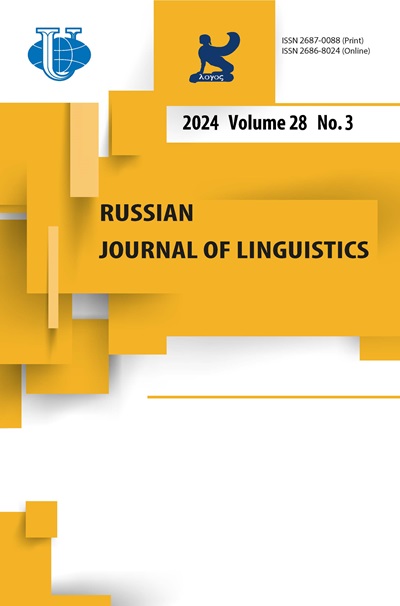Vol 22, No 3 (2018): Studies in semantics: for Anna Wierzbicka’s anniversary
- Year: 2018
- Articles: 10
- URL: https://journals.rudn.ru/linguistics/issue/view/1103
- DOI: https://doi.org/10.22363/2312-9182-2018-22-3
Full Issue
STUDIES IN SEMANTICS: For Anna Wierzbicka’s anniversary
Anna Wierzbicka, Words and the World
Abstract
This introduction to the Special Issue summarises Anna Wierzbicka’s contribution to the linguistic study of meaning. It presents the foundations of the approach known as the Natural Semantic Metalanguage (NSM) developed by Wierzbicka. The current state of the approach is discussed in the article with the ideas of 65 semantic primitives, universal grammar and the principle of reductive paraphrase in semantic explications. It traces the origin of Wierzbicka’s ideas to Leibniz. The framework has been tested on about thirty languages of diverse origin. The applications of the approach are broad and encompass lexical areas of emotions, social categories, speech act verbs, mental states, artefacts and animals, verbs of motion, kinship terms (among others), as well as grammatical constructions.
 499-520
499-520


Anna Wierzbicka, Semantic Decomposition, and the Meaning-Text Approach
Abstract
 521-538
521-538


A Semantic Menagerie: The Conceptual Semantics of Ethnozoological Categories
Abstract
 539-559
539-559


A Corpus Investigation of English Cognition Verbs and their Effect on the Incipient Epistemization of Physical Activity Verbs
Abstract
 560-580
560-580


The Semantics of Logical Connectors: therefore, moreover and in fact
Abstract
 581-604
581-604


Notes on Russian Number
Abstract
 605-627
605-627


Towards a Semantic Analysis of Russian Discourse Markers: pozhaluj, nikak, vsjo-taki
Abstract
 628-652
628-652


Russian Constructions with Syntactic Reduplication of Colour Terms: A Corpus Study
Abstract
 653-674
653-674


Russian Words for ‘freedom’ Revisited
Abstract
 675-700
675-700


REVIEWS
Analysis of Kinship Terms Using Natural Semantic Metalanguage: Anna Wierzbicka’s Approach
Abstract
 701-710
701-710

















